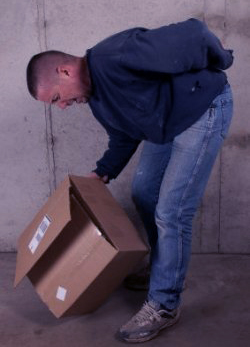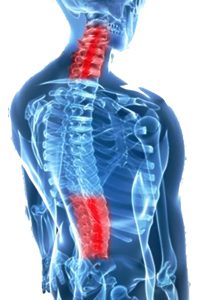Disc Injuries
Injuries to the intervertebral discs of the lumbosacral spine are invoked as a causitive factor in one of the most common health prolems in the United States- low back pain (LBP). Of the many possible etiologies of LBP, the intervertebral disc has been implicated as a far more frequent source than muscular strain or ligamentous sprain.
 Disc herniations can result from general wear and tear, such as when performing jobs that require constant sitting. However, herniations often result from jobs that require lifting. Traumatic (quick) injury to the lumbar discs commonly occurs when lifting while bent at the waist, rather than lifting with the legs while the back is straight. Minor back pain and chronic back tiredness are indicators of general wear and tear that make one susceptible to herniation on the occurence of a traumatic event, such as bending to pick up a pencil or falling. When the spine is straight, such as in standing or lying down, internal pressure is equalized on all parts of the discs. While sitting or bending to lift, internal pressure on a disc can increase from 17 psi (lying down) to 300 psi (lifting with a rounded back).
Disc herniations can result from general wear and tear, such as when performing jobs that require constant sitting. However, herniations often result from jobs that require lifting. Traumatic (quick) injury to the lumbar discs commonly occurs when lifting while bent at the waist, rather than lifting with the legs while the back is straight. Minor back pain and chronic back tiredness are indicators of general wear and tear that make one susceptible to herniation on the occurence of a traumatic event, such as bending to pick up a pencil or falling. When the spine is straight, such as in standing or lying down, internal pressure is equalized on all parts of the discs. While sitting or bending to lift, internal pressure on a disc can increase from 17 psi (lying down) to 300 psi (lifting with a rounded back).
 Cervical
Cervical
Cervical disc herniations occur in the neck, most often between the fifth and sixth (C5/6) and the sixth and seventh (C6/&7) cervical vertebral bodies. Symptons can affect the back of the skull, the neck, shoulder girdle, scapula, shoulder, arm and hand.
Lumbar
Lumbar disc herniations occur in the lower back, most often between the fourth and fifth lumbar vertebral bodies and between the fifth and the sacrum. Symptons can affect the lower back, buttocks, thigh, anal/genital region (via the perineal nerve), and may radiate into the foot and/or toe. The sciatic nerve is the most commonly affected nerve, causing symptons of sciatica. The femoral nerve can also be affected and cause the patient to experience a numb, tingling feeling throughout one or both legs and even feet or even a burning feeling in the hips and legs.
